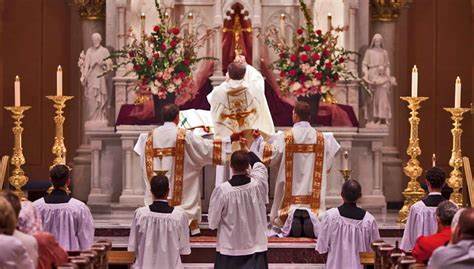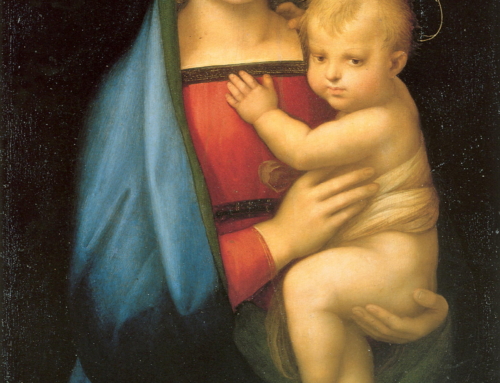At Our Lady of the Rosary in Greenville the Mass is celebrated in a traditional style with the priest offering the sacrifice of the Mass facing the same direction as the people. The Novus Ordo Mass is enhanced with the Gloria, Sanctus, Agnus Dei and Paternoster all in Latin and sung to Gregorian chant. The choir helps to lead the worship with chant, sacred polyphony and classic hymns. At the solemn Mass there are clouds of incense and plenty of well trained altar boys. Most of the people receive Holy Communion on the tongue, kneeling at an altar rail.
Some may criticize this style of Catholic worship as “backwardist, out of touch, and out of date” Others might accuse us of longing for some golden age in the past–hopelessly nostalgic for a make believe Catholicism that has passed its sell by date. They believe the church will die if it does not adapt–that unless the church is relevant it is ridiculous–no more than an ecclesiastical museum–a churchy version of Grandma’s attic. For them the music, the buildings, the preaching, the entire Mass must be current, relevant and with it.
No doubt they have a point, and it is true that some traditionalists can become so obsessed with traditional worship that it becomes a kind of idol–the sign of a sectarian or even cult-like mentality in which adherence to certain rubrics, quaint customs and certain rules and regulations dominates everything. When traditional worship goes to the extreme there is a tendency towards fussiness, baroque over elaboration, legalism and self righteousness.
However, when the “relevant” Catholics go to extremes there is also a tendency toward sectarian and cult like behavior in which a woke ideology predominates and there develops a kind of tyranny of tenderness–in which everything disintegrates into sentimentalism and an obsession with making Catholicism useful.
The first sort, we might name “Reverence first” Catholics prioritize saving souls and neglect saving the world. The second sort who we might name “Relevance first” Catholics prioritize saving the world and neglect saving souls.
It should be clear that to be fully Catholic we need both–however, how do we do both? It seems to me that in the life of the church we can divide these two along the lines of the two great commandments–to love God and love our neighbor.
Both are important, but one comes before the other. We are to love God first and then love our neighbor. However, this should not mean that the second commandment is to be neglected.
How are these two put into effect? I think the problem comes when folks feel like the liturgy has to “do everything” that therefore, the liturgy itself has to be relevant and show that we are loving our neighbor. Consequently the priest has to be cool, make his homilies cute and entertaining, use groovy music, put everybody from the ladies cookie baking group to the readers and ushers into the procession, make the liturgy “family friendly” by dumbing it down etc. etc.
Instead the liturgy is the place for reverence–for loving God. The action of the church in the world–through everyday labor, through charitable service, through education and health care–this is where we love our neighbor. The two aspects are intertwined, but not intermixed.
Thus, our work in the world is inspired and empowered by our worship and our reverent worship is the place to pray for and motivate our work in the world.
I nearly entitled this post “Reverence or Relevance”. I changed it to Reverence AND Relevance.”







Leave A Comment
You must be logged in to post a comment.